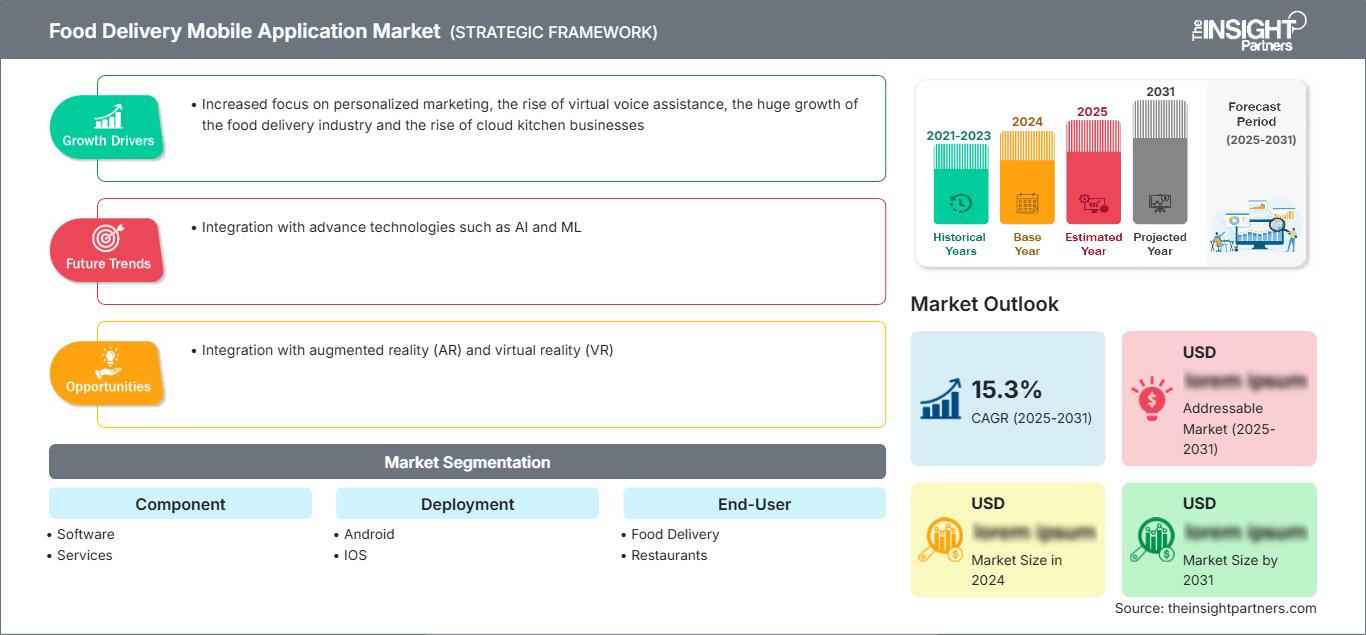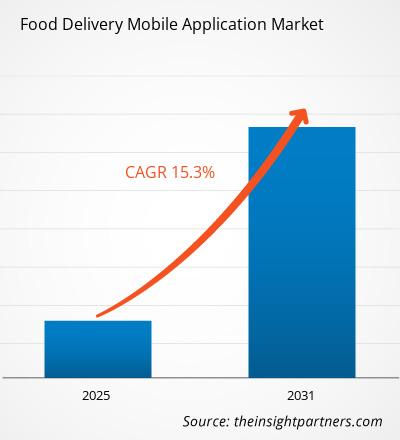음식 배달 모바일 애플리케이션 시장 규모는 2031년까지 1,435억 7천만 달러에 이를 것으로 예상됩니다. 이 시장은 2025년부터 2031년까지 16.2%의 CAGR을 기록할 것으로 예상됩니다. 이는 시장의 주요 추세로 남을 가능성이 높습니다.
음식 배달 모바일 애플리케이션 시장 분석
- 음식 배달 모바일 애플리케이션 시장은 현재 시장 동향과 예측 기간 동안의 예상 가능한 영향으로 인해 성장 전망이 있습니다.
- 음식 배달 모바일 애플리케이션 시장은 개인화된 마케팅에 대한 관심 증가, 가상 음성 지원의 증가, 음식 배달 산업의 엄청난 성장, 클라우드 키친 비즈니스의 증가 등의 요인으로 인해 성장하고 있습니다.
- AI, ML과 같은 첨단 기술과의 통합을 통해 음식 배달 모바일 애플리케이션 시장에 수익성 있는 기회를 제공합니다.
음식 배달 모바일 애플리케이션 시장 개요
- 음식 배달 앱은 고객을 근처 식당, 슈퍼마켓, 편의점 및 기타 사업체와 연결하여 음식을 쉽게 구매할 수 있는 방법을 제공하는 일종의 레스토랑 배달/테이크아웃 소프트웨어입니다.
- 음식 배달 앱은 레스토랑이나 가맹점의 메뉴와 음식을 보여줍니다. 고객은 이러한 제3자 배달 서비스를 통해 음식을 구매하여 집 앞까지 바로 배달받을 수 있습니다.
- 최근 몇 년 동안 글로벌 음식 배달 앱 시장은 눈에 띄게 빠르게 성장했습니다. 스타트업부터 다국적 기업까지 모든 규모의 기업들이 이 전략을 활용하여 고객 기반을 확대하고 서비스의 품질을 향상시키고 있습니다.
이 보고서의 일부 또는 국가 수준 분석, Excel 데이터 팩을 포함하여 모든 보고서에 대한 사용자 정의를 무료로 받을 수 있으며, 스타트업 및 대학을 위한 훌륭한 혜택과 할인도 이용할 수 있습니다.
음식 배달 모바일 애플리케이션 시장: 전략적 통찰력

-
이 보고서의 주요 시장 동향을 알아보세요.이 무료 샘플에는 시장 동향부터 추정치 및 예측까지 다양한 데이터 분석이 포함됩니다.
식품 배달 모바일 애플리케이션 시장 동인 및 기회 클라우드 키친 기업의 시장 선호 증가
- 음식 배달에 대한 수요가 커지면서 클라우드 키친(가상 키친 또는 고스트 키친이라고도 함)이 점점 더 인기를 얻고 있습니다.
- 이러한 주방은 온라인 주문 처리에만 집중하여, 매장 식사 공간의 필요성을 없애고 간접 비용을 절감합니다.
- 요리사와 기업이 요리와 배달 업무에만 집중할 수 있게 되면서 이러한 기업은 레스토랑 부문을 완전히 변화시키고 있습니다.
- 클라우드 키친은 온라인 주문만 접수하여 주문 처리 속도를 높일 것입니다. 클라우드 키친은 음식 배달 앱이 오프라인 매장 없이도 다양한 장소에서 운영될 수 있도록 지원함으로써 더 많은 고객에게 다가갈 수 있도록 지원합니다. 이를 통해 앱 사업 확장과 매출 증대에 기여할 수 있습니다.
AI와 자동화의 부상
- 사용자 경험을 개선하는 개인화된 추천을 제공하기 위해 AI와 ML 기술은 사용자의 주문 내역, 선호도, 행동을 조사합니다.
- AI 시스템은 사용자의 식단 제한과 이전 선택 사항을 바탕으로 사용자가 어떤 음식을 좋아할지 예측할 수 있습니다.
- 음식을 제공하는 앱은 AI로 구동되는 챗봇과 가상 비서를 통합하여 원활한 고객 서비스를 제공합니다.
- 이러한 AI 기반 기능은 고객 문의, 주문 처리, 불만 처리 등을 통해 고객이 앱에 빠르고 쉽게 접속할 수 있도록 지원합니다. 이러한 전략은 고객 만족도 향상과 기업 운영 간소화라는 두 가지 이점을 제공합니다.
음식 배달 모바일 애플리케이션 시장 보고서 세분화 분석
음식 배달 모바일 애플리케이션 시장 분석에 기여한 주요 세그먼트는 구성 요소, 배포 및 최종 사용자입니다.
- 구성 요소별로 시장은 소프트웨어와 서비스로 나뉩니다.
- 시장은 배포 방식에 따라 안드로이드, IOS 등으로 세분화됩니다.
- 최종 사용자별로 시장은 음식 배달, 레스토랑 및 기타로 세분화됩니다.
지역별 음식 배달 모바일 애플리케이션 시장 점유율 분석
- 음식 배달 모바일 애플리케이션 시장 보고서는 북미, 유럽, 아시아 태평양(APAC), 중동 및 아프리카(MEA), 남미 및 중미를 포함하여 현재 및 과거 시장 규모와 2021년부터 2031년까지의 예측을 포함한 5개 주요 지역에 대한 자세한 분석으로 구성되어 있습니다.
- 각 지역은 국가별로 세분화됩니다. 이 보고서는 18개국 이상에 대한 분석 및 예측을 제공하며, 지역 수준에서 시장에 영향을 미치는 성장 동력, 트렌드, 기회 등 음식 배달 모바일 애플리케이션 시장 역학을 다룹니다.
- 또한, 보고서는 PEST 분석도 다루고 있는데, 이는 이 지역의 식품 배달 모바일 애플리케이션 시장에 영향을 미치는 주요 요인을 연구하는 것입니다.
음식 배달 모바일 애플리케이션 시장 지역별 통찰력
The Insight Partners의 분석가들은 예측 기간 동안 음식 배달 모바일 애플리케이션 시장에 영향을 미치는 지역별 동향과 요인을 면밀히 분석했습니다. 이 섹션에서는 북미, 유럽, 아시아 태평양, 중동 및 아프리카, 그리고 중남미 지역의 음식 배달 모바일 애플리케이션 시장 부문과 지역별 현황도 살펴봅니다.
음식 배달 모바일 애플리케이션 시장 보고서 범위
| 보고서 속성 | 세부 |
|---|---|
| 2024년 시장 규모 | XX억 달러 |
| 2031년까지 시장 규모 | 1,435억 7천만 달러 |
| 글로벌 CAGR(2025~2031년) | 16.2% |
| 역사적 데이터 | 2021-2023 |
| 예측 기간 | 2025-2031 |
| 다루는 세그먼트 |
구성 요소별
|
| 포함된 지역 및 국가 |
북아메리카
|
| 시장 선도 기업 및 주요 회사 프로필 |
|
음식 배달 모바일 애플리케이션 시장 참여자 밀도: 비즈니스 역학에 미치는 영향 이해
음식 배달 모바일 애플리케이션 시장은 소비자 선호도 변화, 기술 발전, 그리고 제품의 장점에 대한 인식 제고 등의 요인으로 인한 최종 사용자 수요 증가에 힘입어 빠르게 성장하고 있습니다. 수요가 증가함에 따라 기업들은 제품 및 서비스를 확장하고, 소비자 니즈를 충족하기 위한 혁신을 추진하며, 새로운 트렌드를 적극 활용하고 있으며, 이는 시장 성장을 더욱 가속화하고 있습니다.

- 음식 배달 모바일 애플리케이션 시장 주요 주요 업체 개요를 확인하세요
음식 배달 모바일 애플리케이션 시장 뉴스 및 최근 동향
음식 배달 모바일 애플리케이션 시장은 1차 및 2차 조사 후 주요 기업 간행물, 협회 데이터, 데이터베이스 등 정성적 및 정량적 데이터를 수집하여 평가합니다. 음식 배달 모바일 애플리케이션 시장의 몇 가지 동향은 다음과 같습니다.
- 주문형 편의 플랫폼 스위기(Swiggy)는 음식 배달 서비스 '글로벌 최초' 기능인 '잇리스트(Eatlists)'를 출시한다고 발표했습니다. 이 기능은 사용자가 음식 추천을 찾고 공유하는 방식을 혁신할 것입니다. 스위기의 '잇리스트' 기능을 통해 미식가들은 스위기 앱에서 직접 좋아하는 요리를 선별하고 공유할 수 있습니다. (스위기, 보도자료, 2024년 7월)
- 인스타카트가 우버와 제휴하여 미국 고객에게 음식 배달 서비스를 제공합니다. 이제 인스타카트 고객은 식료품 배달 플랫폼 앱을 사용하여 미국 전역의 수십만 개 우버이츠 파트너 레스토랑에서 주문할 수 있습니다. (삼성전자, 보도자료, 2024년 5월)
- 삼성전자가 AI 기반 개인 맞춤형 푸드 및 레시피 플랫폼 '삼성 푸드'를 출시한다고 발표했습니다. 삼성 푸드는 16만 개 이상의 레시피를 통해 종합적인 푸드 경험을 제공하며, 사용자가 새로운 요리를 찾고, 맞춤형 식단을 만들고, 온라인으로 재료를 주문할 수 있도록 돕는 개인화된 비서 역할을 합니다. 또한, 이 서비스는 사용자가 조리 기기를 제어할 수 있도록 지원하고, 단계별 조리 가이드를 제공하며, 좋아하는 레시피를 소셜 미디어에 공유할 수 있도록 지원합니다. (삼성전자, 보도자료, 2023년 8월)
음식 배달 모바일 애플리케이션 시장 보고서 범위 및 성과물
"음식 배달 모바일 애플리케이션 시장 규모 및 예측(2021~2031)" 보고서는 아래 영역을 포괄하여 시장에 대한 자세한 분석을 제공합니다.
- 범위에 포함된 모든 주요 시장 부문에 대한 글로벌, 지역 및 국가 수준의 식품 배달 모바일 애플리케이션 시장 규모 및 예측
- 식품 배달 모바일 애플리케이션 시장 동향 및 운전자, 제약 및 주요 기회와 같은 시장 역학
- 자세한 PEST/포터의 5가지 힘 및 SWOT 분석
- 주요 시장 동향, 글로벌 및 지역 프레임워크, 주요 업체, 규정 및 최근 시장 개발 사항을 다루는 음식 배달 모바일 애플리케이션 시장 분석
- 시장 집중도, 히트맵 분석, 주요 업체 및 식품 배달 모바일 애플리케이션 시장의 최근 개발 사항을 다루는 산업 환경 및 경쟁 분석
- 자세한 회사 프로필
- 과거 분석(2년), 기준 연도, CAGR을 포함한 예측(7년)
- PEST 및 SWOT 분석
- 시장 규모 가치/거래량 - 글로벌, 지역, 국가
- 산업 및 경쟁 환경
- Excel 데이터세트
최근 보고서
관련 보고서
사용 후기
구매 이유
- 정보에 기반한 의사 결정
- 시장 역학 이해
- 경쟁 분석
- 고객 인사이트
- 시장 예측
- 위험 완화
- 전략 기획
- 투자 타당성 분석
- 신흥 시장 파악
- 마케팅 전략 강화
- 운영 효율성 향상
- 규제 동향에 발맞춰 대응






















 무료 샘플 받기 - 음식 배달 모바일 애플리케이션 시장
무료 샘플 받기 - 음식 배달 모바일 애플리케이션 시장